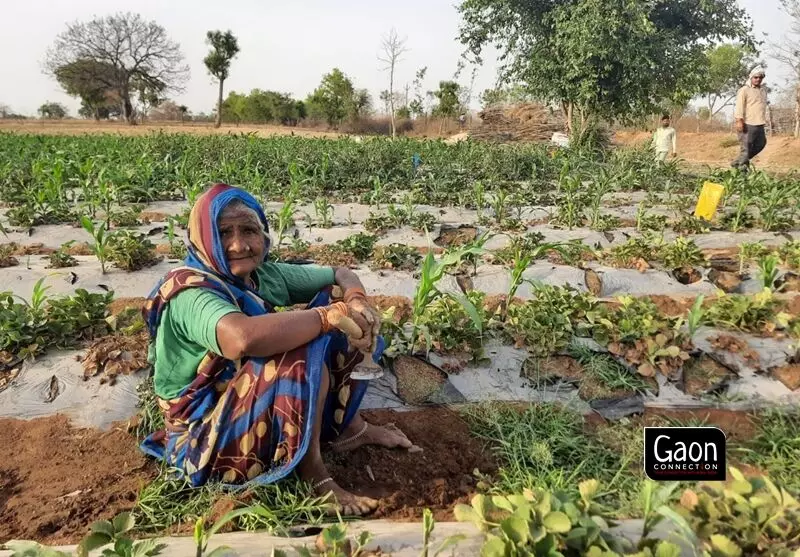40% distressed farmers did not benefit from farm loan waiver in Maharashtra, UP, Punjab: Study
A joint study by NABARD and Bharat Krishak Samaj has found that four in ten distressed surveyed farmers did not receive any farm loan waiver benefits in Punjab, Maharashtra, and Uttar Pradesh, which together comprise 27 per cent of the total Indian agricultural landholdings. The study also found that borrowings of an average Punjab farmer were far greater than their counterparts in Maharashtra and Uttar Pradesh.
 गाँव कनेक्शन 25 April 2022 12:35 PM GMT
गाँव कनेक्शन 25 April 2022 12:35 PM GMT

A farmer in her strawberry farm, Jhansi. Photo: Shivani Gupta
More than 40 per cent of the "very highly" distressed surveyed farmers in Maharashtra, Uttar Pradesh, and Punjab did not receive any farm loan waivers (FLW) benefits. This was revealed in a joint study recently released by the National Bank for Agriculture and Rural Development (NABARD) and the Bharat Krishak Samaj, a farmers' organisation.
As part of the study titled Farm Loan Waivers in India: Assessing Impact and Looking Ahead, 3,000 farmers in the three states were interviewed. Of this, 84 per cent were small and marginal farmers. Between 72 to 85 per cent of respondents in the three states agreed that farm loan waivers pushed honest farmers to default on agricultural loans. The three states account for 27 per cent of the total Indian agricultural landholdings.
"The farm loan waiver schemes were originally designed as one-off events to protect both the banks and the farmers from the problems of debt-overhang. However, by increasing the frequency of waivers and by universalizing its distribution that is mostly unconnected to levels of farmer distress, the benevolent purpose the scheme was to achieve appears to have been diluted leading to worsening credit culture in the country," read the joint report.
"The implementation of FLW schemes does not appear to have a statistically significant inflationary effect," it concluded.
Average outstanding and waived FLW amounts (in Rs lakh) full-waiver beneficiaries.
Average outstanding and waived FLW amounts (in Rs lakhs) partial-waiver beneficiaries.
Farm loan waivers are customised schemes announced by state governments to help the distressed farmers during crop loss as a result of natural calamity such as drought and floods or poor monsoon and farmers are unable to repay loans.
Eighteen Indian states including Chhattisgarh, Karnataka, Rajasthan, have implemented FLW schemes since 2012 and about Rs 2,510 billion farm loan has been waived off by states. The three states covered in the recent joint study – Maharashtra, Uttar Pradesh (UP), and Punjab – were declared FLWs in the financial year 2017-18.
As per the study, released on April 22, income instability due to increased cost of cultivation, damage to crop/livestock or fall in market prices received by farmers emerged as primary reasons for farmer distress in the three states.
Farmer suicide and COVID distress
In the wake of COVID-19 related restrictions, 15 families with suicide cases in the three states were analysed, with five families in Punjab, four in Maharashtra and six in UP. In all three states, successive crop loss and indebtedness together were the prime causes of farmer suicides. Sole dependence on agriculture for income was another major cause of farmer suicides in Uttar Pradesh.
The joint study by NABARD and Bharat Krishak Samaj also found that an average Punjab farmer borrowed a much larger amount compared to farmers in Maharashtra and Uttar Pradesh. A marginal farmer in Punjab, on average, annually borrowed about Rs 340,000 — four times as much as in Uttar Pradesh (Rs 84,000) and five times as much in Maharashtra (Rs 62,000).
Meanwhile, as per the latest National Statistical Office (NSO) survey, Situation Assessment of Agricultural Households and Land Holdings of Households in Rural India, 2019, which was released in September last year, every second agricultural household in India is indebted. On an average, outstanding loan per agricultural household is Rs 74,121.
What can be done?
The recent joint report has suggested a few recommendations to support a distressed farmer in a sustainable manner:
1. Increase the coverage and availability of institutional credit.
2. An effective law to regulate non-institutional sources of credit.
3. Create a farmer distress index.
4. Use grants to support distressed farmers and prioritise credit repayment.
5. A credit guarantee fund for agricultural loans.
6. Improve farmer's access to markets.
7. Address infrastructure deficit in rural areas.
8. Effectively deploying crop insurance.
9. Leverage technology to support farmers.
#farm loan waiver #farmers #story
More Stories




